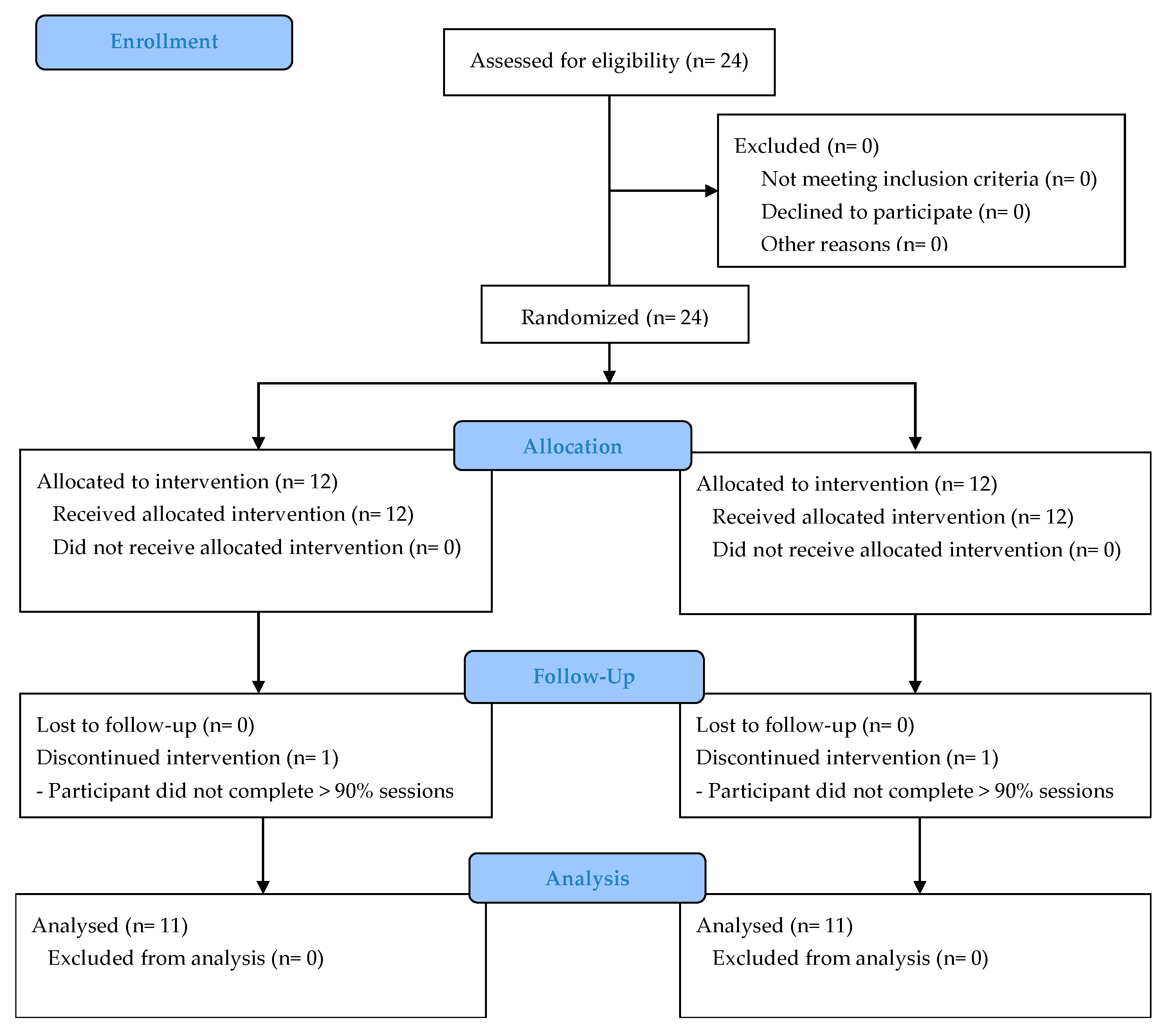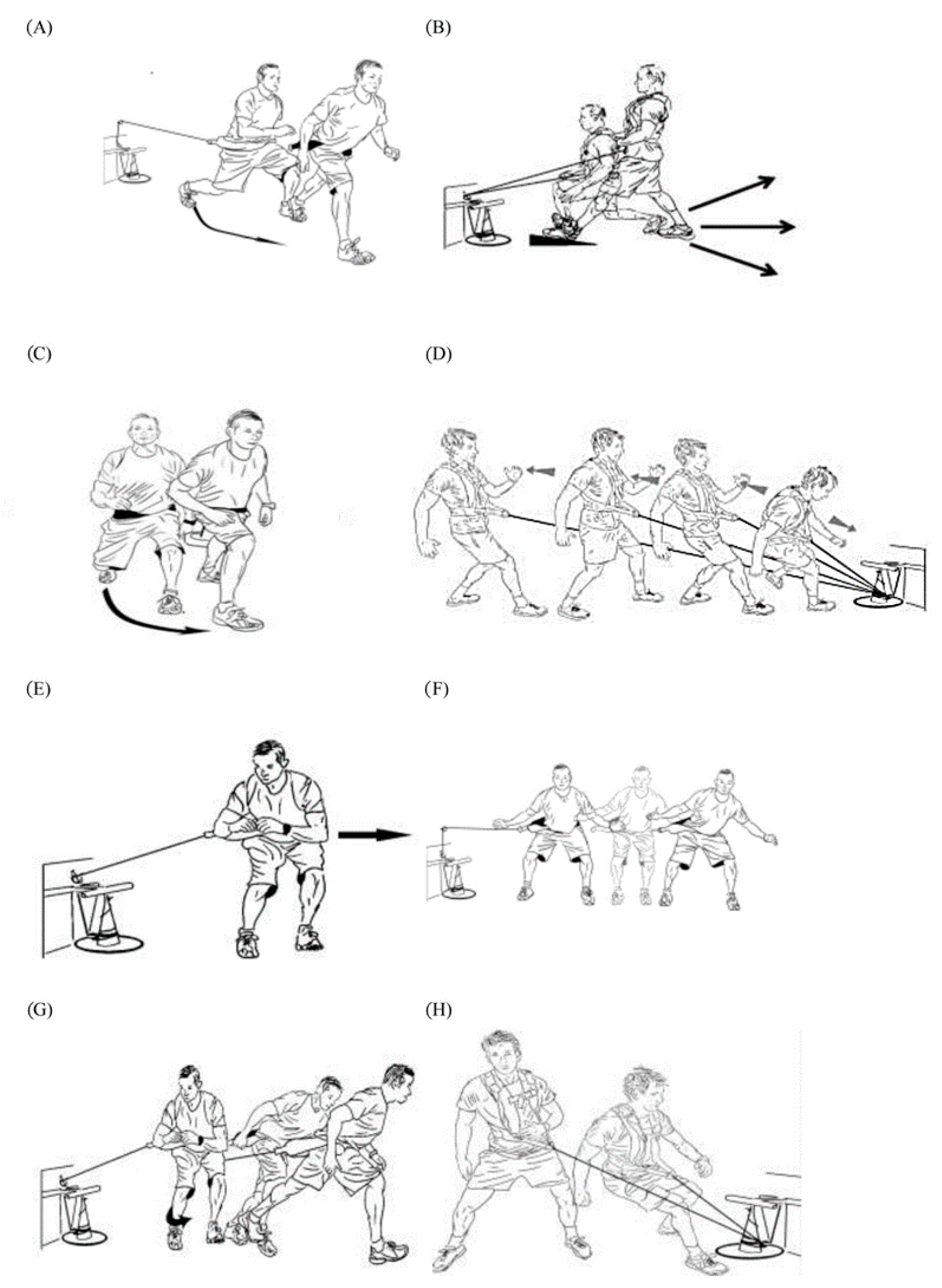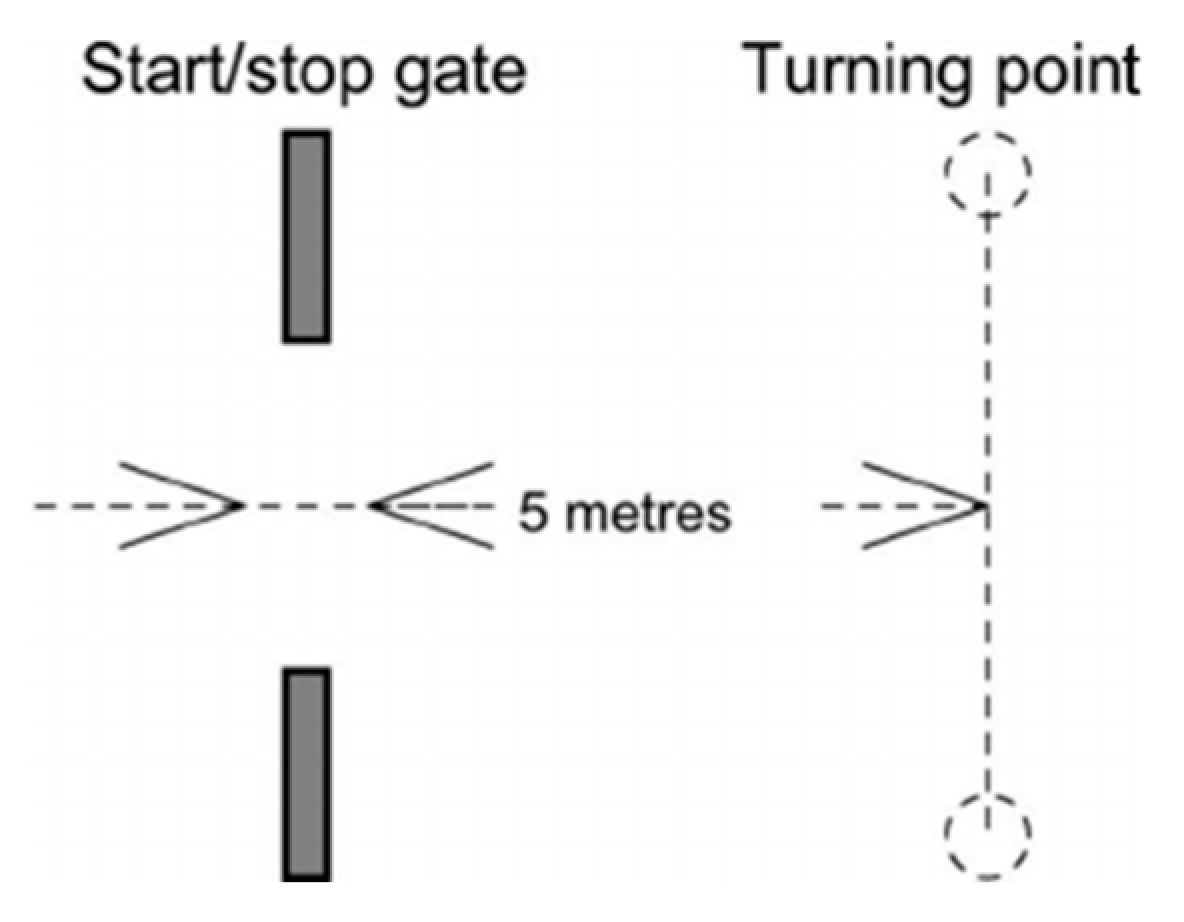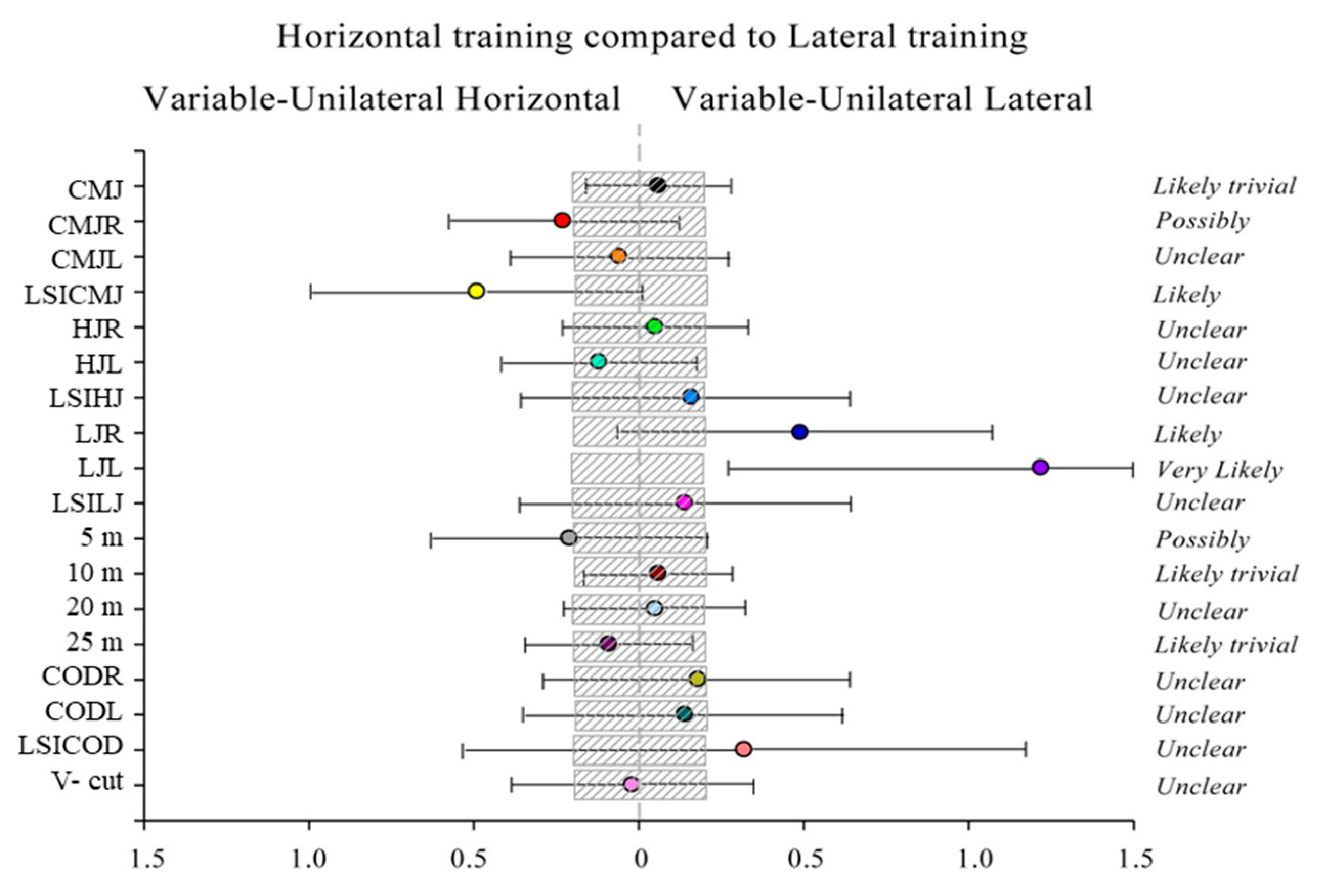Effects of Direction-Specific Training Interventions on Physical Performance and Inter-Limb Asymmetries
Abstract
:1. Introduction
2. Materials and Methods
2.1. Participants
2.2. Study Design
2.3. Procedures
2.3.1. Training Intervention
2.3.2. Functional Performance Tests
2.3.3. Countermovement Jump Test
2.3.4. Lateral and Horizontal Jump Tests
2.3.5. Speed Tests
2.3.6. COD Tests
2.3.7. V-Cut Test
2.3.8. LSI
2.4. Statistical Analyses
3. Results
3.1. Participants
3.2. Intragroup Changes
3.3. Intergroup Changes
4. Discussion
5. Conclusions
Author Contributions
Funding
Institutional Review Board Statement
Informed Consent Statement
Data Availability Statement
Acknowledgments
Conflicts of Interest
References
- Gonzalo-Skok, O.; Tous-Fajardo, J.; Valero-Campo, C.; Berzosa, C.; Bataller, A.V.; Arjol-Serrano, J.L.; Moras, G.; Mendez-Villanueva, A. Eccentric-Overload Training in Team-Sport Functional Performance: Constant Bilateral Vertical Versus Variable Unilateral Multidirectional Movements. Int. J. Sports Physiol. Perform. 2017, 12, 951–958. [Google Scholar] [CrossRef] [PubMed]
- Tous-Fajardo, J.; Gonzalo-Skok, O.; Arjol-Serrano, J.L.; Tesch, P. Enhancing Change-of-Direction Speed in Soccer Players by Functional Inertial Eccentric Overload and Vibration Training. Int. J. Sports Physiol. Perform. 2016, 11, 66–73. [Google Scholar] [CrossRef]
- Contreras, B.; Vigotsky, A.D.; Schoenfeld, B.J.; Beardsley, C.; McMaster, D.T.; Reyneke, J.H.T.; Cronin, J.B. Effects of a Six-Week Hip Thrust vs. Front Squat Resistance Training Program on Performance in Adolescent Males: A Randomized Controlled Trial. J. Strength Cond. Res. 2017, 31, 999–1008. [Google Scholar] [CrossRef]
- Abade, E.; Silva, N.; Ferreira, R.; Baptista, J.; Gonçalves, B.; Osório, S.; Viana, J. Effects of Adding Vertical or Horizontal Force-Vector Exercises to In-Season General Strength Training on Jumping and Sprinting Performance of Youth Football Players. J. Strength Cond. Res. 2021, 35, 2769–2774. [Google Scholar] [CrossRef]
- Sannicandro, I.; Cofano, G.; Rosa, R.A.; Piccinno, A. Balance Training Exercises Decrease Lower-Limb Strength Asymmetry in Young Tennis Players. J. Sports Sci. Med. 2014, 13, 397–402. [Google Scholar]
- Gonzalo-Skok, O.; Tous-Fajardo, J.; Suarez-Arrones, L.; Arjol-Serrano, J.L.; Casajús, J.A.; Mendez-Villanueva, A. Single-Leg Power Output and Between-Limbs Imbalances in Team-Sport Players: Unilateral Versus Bilateral Combined Resistance Training. Int. J. Sports Physiol. Perform. 2017, 12, 106–114. [Google Scholar] [CrossRef] [PubMed]
- Pardos-Mainer, E.; Casajús, J.A.; Bishop, C.; Gonzalo-Skok, O. Effects of Combined Strength and Power Training on Physical Performance and Interlimb Asymmetries in Adolescent Female Soccer Players. Int. J. Sports Physiol. Perform. 2020, 15, 1147–1155. [Google Scholar] [CrossRef]
- Gonzalo-Skok, O.; Moreno-Azze, A.; Arjol-Serrano, J.L.; Tous-Fajardo, J.; Bishop, C. A Comparison of 3 Different Unilateral Strength Training Strategies to Enhance Jumping Performance and Decrease Interlimb Asymmetries in Soccer Players. Int. J. Sports Physiol. Perform. 2019, 1256–1264. [Google Scholar] [CrossRef]
- Bini, R.R.; Hume, P.A. Relationship between Pedal Force Asymmetry and Performance in Cycling Time Trial. J. Sports Med. Phys. Fitness 2015, 55, 892–898. [Google Scholar] [PubMed]
- Bishop, C.; Turner, A.; Read, P. Effects of Inter-Limb Asymmetries on Physical and Sports Performance: A Systematic Review. J. Sports Sci. 2018, 36, 1135–1144. [Google Scholar] [CrossRef]
- Maloney, S.J. The Relationship Between Asymmetry and Athletic Performance: A Critical Review. J. Strength Cond. Res. 2019, 33, 2579–2593. [Google Scholar] [CrossRef]
- Madruga-Parera, M.; Bishop, C.; Fort-Vanmeerhaeghe, A.; Beato, M.; Gonzalo-Skok, O.; Romero-Rodríguez, D. Effects of 8 Weeks of Isoinertial vs. Cable-Resistance Training on Motor Skills Performance and Interlimb Asymmetries. J. Strength Cond. Res. 2020. [Google Scholar] [CrossRef] [PubMed]
- Gonzalo-Skok, O.; Sánchez-Sabaté, J.; Izquierdo-Lupón, L.; Sáez de Villarreal, E. Influence of Force-Vector and Force Application Plyometric Training in Young Elite Basketball Players. Eur. J. Sport Sci. 2019, 19, 305–314. [Google Scholar] [CrossRef] [PubMed]
- Suchomel, T.J.; Wagle, J.P.; Douglas, J.; Taber, C.B.; Harden, M.; Haff, G.G.; Stone, M.H. Implementing Eccentric Resistance Training-Part 1: A Brief Review of Existing Methods. J. Funct. Morphol. Kinesiol. 2019, 4, 38. [Google Scholar] [CrossRef] [Green Version]
- Hewit, J.K.; Cronin, J.B.; Hume, P.A. Asymmetry in Multi-Directional Jumping Tasks. Phys. Ther. Sport Off. J. Assoc. Chart. Physiother. Sports Med. 2012, 13, 238–242. [Google Scholar] [CrossRef] [PubMed]
- Gonzalo-Skok, O.; Tous-Fajardo, J.; Suarez-Arrones, L.; Arjol-Serrano, J.L.; Casajús, J.A.; Mendez-Villanueva, A. Validity of the V-Cut Test for Young Basketball Players. Int. J. Sports Med. 2015, 36, 893–899. [Google Scholar] [CrossRef]
- Gustavsson, A.; Neeter, C.; Thomeé, P.; Silbernagel, K.G.; Augustsson, J.; Thomeé, R.; Karlsson, J. A Test Battery for Evaluating Hop Performance in Patients with an ACL Injury and Patients Who Have Undergone ACL Reconstruction. Knee Surg. Sports Traumatol. Arthrosc. Off. J. ESSKA 2006, 14, 778–788. [Google Scholar] [CrossRef]
- Hopkins, W.G.; Marshall, S.W.; Batterham, A.M.; Hanin, J. Progressive Statistics for Studies in Sports Medicine and Exercise Science. Med. Sci. Sports Exerc. 2009, 41, 3–13. [Google Scholar] [CrossRef] [Green Version]
- Ardern, C.L.; Webster, K.E.; Taylor, N.F.; Feller, J.A. Return to the Preinjury Level of Competitive Sport after Anterior Cruciate Ligament Reconstruction Surgery: Two-Thirds of Patients Have Not Returned by 12 Months after Surgery. Am. J. Sports Med. 2011, 39, 538–543. [Google Scholar] [CrossRef]
- Fort-Vanmeerhaeghe, A.; Bishop, C.; Buscà, B.; Aguilera-Castells, J.; Vicens-Bordas, J.; Gonzalo-Skok, O. Inter-Limb Asymmetries Are Associated with Decrements in Physical Performance in Youth Elite Team Sports Athletes. PLoS ONE 2020, 15, e0229440. [Google Scholar] [CrossRef] [Green Version]
- Bishop, C.; Brashill, C.; Abbott, W.; Read, P.; Lake, J.; Turner, A. Jumping Asymmetries Are Associated With Speed, Change of Direction Speed, and Jump Performance in Elite Academy Soccer Players. J. Strength Cond. Res. 2021, 35, 1841–1847. [Google Scholar] [CrossRef]
- Madruga-Parera, M.; Romero-Rodríguez, D.; Bishop, C.; Beltran-Valls, M.R.; Latinjak, A.T.; Beato, M.; Fort-Vanmeerhaeghe, A. Effects of Maturation on Lower Limb Neuromuscular Asymmetries in Elite Youth Tennis Players. Sports 2019, 7, 106. [Google Scholar] [CrossRef] [Green Version]
- Dos’Santos, T.; McBurnie, A.; Comfort, P.; Jones, P.A. The Effects of Six-Weeks Change of Direction Speed and Technique Modification Training on Cutting Performance and Movement Quality in Male Youth Soccer Players. Sports 2019, 7, 205. [Google Scholar] [CrossRef] [Green Version]
- de Hoyo, M.; Gonzalo-Skok, O.; Sañudo, B.; Carrascal, C.; Plaza-Armas, J.R.; Camacho-Candil, F.; Otero-Esquina, C. Comparative Effects of In-Season Full-Back Squat, Resisted Sprint Training, and Plyometric Training on Explosive Performance in U-19 Elite Soccer Players. J. Strength Cond. Res. 2016, 30, 368–377. [Google Scholar] [CrossRef] [PubMed]
- Rodríguez-Rosell, D.; Franco-Márquez, F.; Pareja-Blanco, F.; Mora-Custodio, R.; Yáñez-García, J.M.; González-Suárez, J.M.; González-Badillo, J.J. Effects of 6 Weeks Resistance Training Combined With Plyometric and Speed Exercises on Physical Performance of Pre-Peak-Height-Velocity Soccer Players. Int. J. Sports Physiol. Perform. 2016, 11, 240–246. [Google Scholar] [CrossRef] [PubMed]
- Freitas, T.T.; Martinez-Rodriguez, A.; Calleja-González, J.; Alcaraz, P.E. Short-Term Adaptations Following Complex Training in Team-Sports: A Meta-Analysis. PLoS ONE 2017, 12, e0180223. [Google Scholar] [CrossRef] [PubMed] [Green Version]
- Meylan, C.; McMaster, T.; Cronin, J.; Mohammad, N.I.; Rogers, C.; Deklerk, M. Single-Leg Lateral, Horizontal, and Vertical Jump Assessment: Reliability, Interrelationships, and Ability to Predict Sprint and Change-of-Direction Performance. J. Strength Cond. Res. 2009, 23, 1140–1147. [Google Scholar] [CrossRef] [PubMed]
- Gonzalo-Skok, O.; Tous-Fajardo, J.; Arjol-Serrano, J.L.; Suarez-Arrones, L.; Casajús, J.A.; Mendez-Villanueva, A. Improvement of Repeated-Sprint Ability and Horizontal-Jumping Performance in Elite Young Basketball Players With Low-Volume Repeated-Maximal-Power Training. Int. J. Sports Physiol. Perform. 2016, 11, 464–473. [Google Scholar] [CrossRef] [PubMed]
- Askling, C.; Karlsson, J.; Thorstensson, A. Hamstring Injury Occurrence in Elite Soccer Players after Preseason Strength Training with Eccentric Overload. Scand. J. Med. Sci. Sports 2003, 13, 244–250. [Google Scholar] [CrossRef] [PubMed]
- de Hoyo, M.; de la Torre, A.; Pradas, F.; Sañudo, B.; Carrasco, L.; Mateo-Cortes, J.; Domínguez-Cobo, S.; Fernandes, O.; Gonzalo-Skok, O. Effects of Eccentric Overload Bout on Change of Direction and Performance in Soccer Players. Int. J. Sports Med. 2015, 36, 308–314. [Google Scholar] [CrossRef]
- Los Arcos, A.; Yanci, J.; Mendiguchia, J.; Salinero, J.J.; Brughelli, M.; Castagna, C. Short-Term Training Effects of Vertically and Horizontally Oriented Exercises on Neuromuscular Performance in Professional Soccer Players. Int. J. Sports Physiol. Perform. 2014, 9, 480–488. [Google Scholar] [CrossRef] [PubMed]
- López-Segovia, M.; Palao Andrés, J.M.; González-Badillo, J.J. Effect of 4 Months of Training on Aerobic Power, Strength, and Acceleration in Two under-19 Soccer Teams. J. Strength Cond. Res. 2010, 24, 2705–2714. [Google Scholar] [CrossRef] [PubMed]
- de Hoyo, M.; Sañudo, B.; Carrasco, L.; Domínguez-Cobo, S.; Mateo-Cortes, J.; Cadenas-Sánchez, M.M.; Nimphius, S. Effects of Traditional Versus Horizontal Inertial Flywheel Power Training on Common Sport-Related Tasks. J. Hum. Kinet. 2015, 47, 155–167. [Google Scholar] [CrossRef] [PubMed] [Green Version]
- Brughelli, M.; Cronin, J.; Levin, G.; Chaouachi, A. Understanding Change of Direction Ability in Sport: A Review of Resistance Training Studies. Sports Med. 2008, 38, 1045–1063. [Google Scholar] [CrossRef] [PubMed]
- Núñez, F.J.; Santalla, A.; Carrasquila, I.; Asian, J.A.; Reina, J.I.; Suarez-Arrones, L.J. The Effects of Unilateral and Bilateral Eccentric Overload Training on Hypertrophy, Muscle Power and COD Performance, and Its Determinants, in Team Sport Players. PLoS ONE 2018, 13, e0193841. [Google Scholar] [CrossRef] [PubMed]
- Suarez-Arrones, L.; Saez de Villarreal, E.; Núñez, F.J.; Di Salvo, V.; Petri, C.; Buccolini, A.; Maldonado, R.A.; Torreno, N.; Mendez-Villanueva, A. In-Season Eccentric-Overload Training in Elite Soccer Players: Effects on Body Composition, Strength and Sprint Performance. PLoS ONE 2018, 13, e0205332. [Google Scholar] [CrossRef]




| Week | Session | VUH Exercises | VUL Exercises | Sets × Repetitions |
|---|---|---|---|---|
| 1 | 1–2 | Side-step | Lateral squat | 1 × 6 |
| Backward lunges | Defensive-like shuffling steps | 1 × 6 | ||
| Crossover cutting | Lateral crossover cutting | 1 × 6 | ||
| Landing and backward lunges | 90° lunge | 1 × 6 | ||
| 2 | 3–4 | Side-step | Lateral squat | 1 × 6 |
| Backward lunges | Defensive-like shuffling steps | 1 × 6 | ||
| Crossover cutting | Lateral crossover cutting | 1 × 6 | ||
| Landing and backward lunges | 90° lunge | 1 × 6 | ||
| 3 | 5–6 | Side-step | Lateral squat | 1 × 8 |
| Backward lunges | Defensive-like shuffling steps | 1 × 8 | ||
| Crossover cutting | Lateral crossover cutting | 1 × 8 | ||
| Landing and backward lunges | 90° lunge | 1 × 8 | ||
| 4 | 7–8 | Side-step | Lateral squat | 1 × 8 |
| Backward lunges | Defensive-like shuffling steps | 1 × 8 | ||
| Crossover cutting | Lateral crossover cutting | 1 × 8 | ||
| Landing and backward lunges | 90° lunge | 1 × 8 | ||
| 5 | 9–10 | Side-step | Lateral squat | 1 × 10 |
| Backward lunges | Defensive-like shuffling steps | 1 × 10 | ||
| Crossover cutting | Lateral crossover cutting | 1 × 10 | ||
| Landing and backward lunges | 90° lunge | 1 × 10 | ||
| 6 | 11–12 | Side-step | Lateral squat | 1 × 10 |
| Backward lunges | Defensive-like shuffling steps | 1 × 10 | ||
| Crossover cutting | Lateral crossover cutting | 1 × 10 | ||
| Landing and backward lunges | 90° lunge | 1 × 10 |
| Pre-Test | Post-Test | % (CL90%) | ES (CL90%) | Chances | Outcome | |
|---|---|---|---|---|---|---|
| CMJ (cm) | 35.4 ± 5.2 | 36.1 ± 5.3 | 1.9 (−0.8; 4.6) | 0.12 (−0.05; 0.28) | 19/81/0% | Likely trivial |
| CMJR (cm) | 17.5 ± 3.0 | 19.2 ± 2.5 | 10.4 (2.7; 18.8) | 0.51 (0.13; 0.88) | 92/8/0% | Likely |
| CMJL (cm) | 19.0 ± 2.4 | 20.6 ± 2.2 | 8.6 (3.5; 13.9) | 0.62 (0.26; 0.99) | 97/3/0% | Very Likely |
| LSICMJ (%) | 88.8 ± 9.3 | 92.6 ± 4.6 | 4.7 (0.0; 9.7) | 0.38 (0.00; 0.77) | 80/19/1% | Likely |
| HJR (cm) | 161.0 ± 16.5 | 169.8 ± 15.5 | 5.6 (2.5; 8.7) | 0.50 (0.22; 0.77) | 96/4/0% | Very Likely |
| HJL (cm) | 157.0 ± 14.5 | 169.5 ± 16.5 | 7.9 (5.0; 10.8) | 0.80 (0.52; 1.08) | 100/0/0% | Most Likely |
| LSIHJ (%) | 94.7 ± 4.5 | 97.0 ± 2.5 | 2.5 (0.0; 5.0) | 0.46 (0.01; 0.91) | 84/15/1% | Likely |
| LJR (cm) | 149.5 ± 13.7 | 154.4 ± 11.4 | 3.4 (−0.1; 6.9) | 0.33 (−0.01; 0.67) | 73/26/1% | Possibly |
| LJL (cm) | 149.7 ± 8.1 | 157.4 ± 10.7 | 5.0 (3.1; 7.0) | 0.83 (0.51; 1.15) | 100/0/0% | Most Likely |
| LSILJ (%) | 92.5 ± 5.4 | 95.2 ± 3.8 | 2.9 (1.0; 4.9) | 0.44 (0.15; 0.73) | 92/8/0% | Likely |
| 5 m (s) | 1.06 ± 0.06 | 1.03 ± 0.06 | 2.9 (1.7; 4.1) | 0.50 (0.28; 0.72) | 98/2/0% | Very Likely |
| 10 m (s) | 1.81 ± 0.07 | 1.79 ± 0.08 | 0.9 (0.2; 1.5) | 0.20 (0.04; 0.35) | 48/52/0% | Possibly |
| 20 m (s) | 3.11 ± 0.13 | 3.11 ± 0.13 | 0.0 (−0.8; 0.8) | 0.01 (−0.18; 0.19) | 4/92/3% | Likely trivial |
| 25 m (s) | 3.73 ± 0.15 | 3.74 ± 0.15 | −0.1 (−0.5; 0.3) | −0.03 (−0.13; 0.07) | 0/99/1% | Very Likely trivial |
| 180°-CODR (s) | 2.69 ± 0.09 | 2.63 ± 0.10 | 2.0 (0.8; 3.3) | 0.55 (0.21; 0.90) | 95/4/0% | Very Likely |
| 180°-CODL (s) | 2.71 ± 0.08 | 2.64 ± 0.11 | 2.6 (1.1; 4.1) | 0.85 (0.35; 1.35) | 98/2/0% | Very Likely |
| LSICOD (%) | 98.1 ± 1.2 | 97.1 ± 2.2 | −1.0 (−2.3; 0.4) | −0.76 (−1.79; 0.27) | 6/11/83% | Likely harmful |
| V-cut (s) | 6.91 ± 0.29 | 6.82 ± 0.19 | 1.2 (0.0; 2.3) | 0.25 (0.00; 0.51) | 65/35/0% | Possibly |
| Pre-Test | Post-Test | % (CL90%) | ES (CL90%) | Chances | Outcome | |
|---|---|---|---|---|---|---|
| CMJ (cm) | 34.9 ± 5.0 | 35.8 ± 4.6 | 2.8 (0.8; 4.9) | 0.18 (0.05; 0.30) | 37/63/0% | Possibly |
| CMJR (cm) | 18.6 ± 4.1 | 19.5 ± 4.3 | 4.8 (2.1; 7.6) | 0.19 (0.08; 0.29) | 42/58/0% | Possibly |
| CMJL (cm) | 19.0 ± 3.7 | 20.3 ± 3.3 | 7.5 (3.6; 11.5) | 0.35 (0.17; 0.52) | 92/8/0% | Likely |
| LSICMJ (%) | 91.1 ± 6.9 | 90.9 ± 7.8 | −0.3 (−2.8; 2.1) | −0.04 (−0.34; 0.25) | 8/74/18% | Unclear |
| HJR (cm) | 165.7 ± 21.1 | 175.6 ± 19.5 | 6.2 (4.0; 8.2) | 0.44 (0.29; 0.59) | 99/1/0% | Very Likely |
| HJL (cm) | 166.8 ± 20.8 | 177.0 ± 19.4 | 6.3 (3.6; 9.1) | 0.43 (0.25; 0.61) | 98/2/0% | Very Likely |
| LSIHJ (%) | 94.0 ± 4.1 | 97.1 ± 2.7 | 3.3 (1.6; 4.9) | 0.69 (0.35; 1.04) | 99/1/0% | Very Likely |
| LJR (cm) | 146.1 ± 22.4 | 156.9 ± 17.9 | 8.0 (4.8; 11.2) | 0.46 (0.28; 0.64) | 99/1/0% | Very Likely |
| LJL (cm) | 143.2 ± 15.0 | 158.5 ± 18.2 | 10.6 (7.2; 14.1) | 0.89 (0.62; 1.17) | 100/0/0% | Almost Certain |
| LSILJ (%) | 92.5 ± 5.9 | 96.0 ± 4.3 | 3.9 (1.0; 6.8) | 0.53 (0.13; 0.92) | 92/8/0% | Likely |
| 5 m (s) | 1.06 ± 0.06 | 1.04 ± 0.05 | 1.7 (−0.4; 3.8) | 0.29 (−0.07; 0.64) | 66/32/2% | Possibly |
| 10 m (s) | 1.82 ± 0.07 | 1.80 ± 0.07 | 1.1 (0.5; 1.7) | 0.27 (0.11; 0.43) | 68/25/7% | Possibly |
| 20 m (s) | 3.12 ± 0.11 | 3.12 ± 012 | 0.1 (−0.7; 1.0) | 0.04 (−0.18; 0.26) | 11/85/4% | Likely trivial |
| 25 m (s) | 3.74 ± 0.13 | 3.76 ± 0.15 | −0.5 (−1.4; 0.4) | −0.12 (−0.35; 0.10) | 1/71/27% | Possibly trivial |
| 180°-CODR (s) | 2.67 ± 0.13 | 2.59 ± 0.17 | 2.8 (1.2; 4.8) | 0.56 (0.24; 0.88) | 97/3/0% | Very Likely |
| 180°-CODL (s) | 2.71 ± 0.17 | 2.62 ± 0.16 | 3.3 (1.3; 5.2) | 0.51 (0.20; 0.82) | 95/5/0% | Very Likely |
| LSICOD (%) | 97.1 ± 2.5 | 96.8 ± 2.0 | −0.3 (−1.7; 1.2) | −0.09 (−0.63; 0.44) | 17/47/36% | Possibly harmful |
| V-cut (s) | 6.99 ± 0.36 | 6.91 ± 0.32 | 1.1 (−0.5; 2.6) | 0.20 (−0.08; 0.48) | 49/49/1% | Possibly |
Publisher’s Note: MDPI stays neutral with regard to jurisdictional claims in published maps and institutional affiliations. |
© 2022 by the authors. Licensee MDPI, Basel, Switzerland. This article is an open access article distributed under the terms and conditions of the Creative Commons Attribution (CC BY) license (https://creativecommons.org/licenses/by/4.0/).
Share and Cite
Gonzalo-Skok, O.; Sánchez-Sabaté, J.; Tous-Fajardo, J.; Mendez-Villanueva, A.; Bishop, C.; Piedrafita, E. Effects of Direction-Specific Training Interventions on Physical Performance and Inter-Limb Asymmetries. Int. J. Environ. Res. Public Health 2022, 19, 1029. https://doi.org/10.3390/ijerph19031029
Gonzalo-Skok O, Sánchez-Sabaté J, Tous-Fajardo J, Mendez-Villanueva A, Bishop C, Piedrafita E. Effects of Direction-Specific Training Interventions on Physical Performance and Inter-Limb Asymmetries. International Journal of Environmental Research and Public Health. 2022; 19(3):1029. https://doi.org/10.3390/ijerph19031029
Chicago/Turabian StyleGonzalo-Skok, Oliver, Jorge Sánchez-Sabaté, Julio Tous-Fajardo, Alberto Mendez-Villanueva, Chris Bishop, and Eduardo Piedrafita. 2022. "Effects of Direction-Specific Training Interventions on Physical Performance and Inter-Limb Asymmetries" International Journal of Environmental Research and Public Health 19, no. 3: 1029. https://doi.org/10.3390/ijerph19031029






